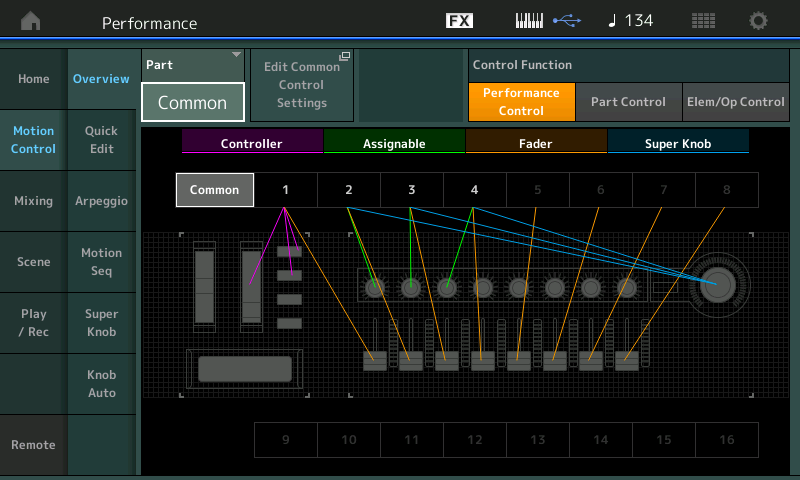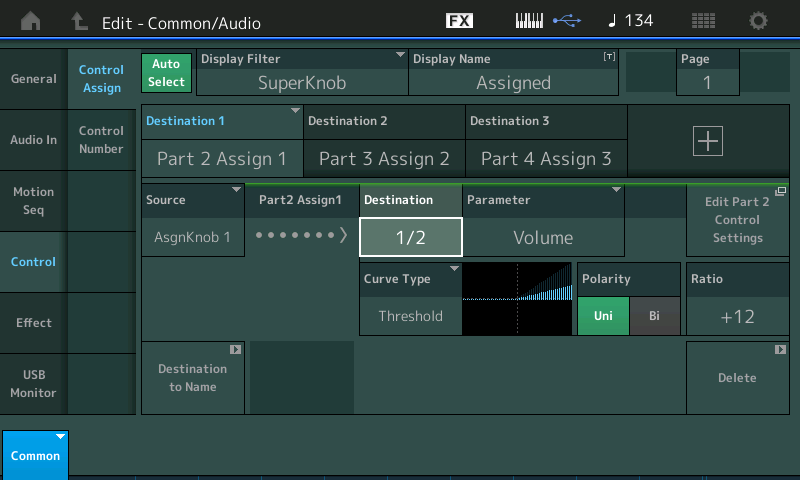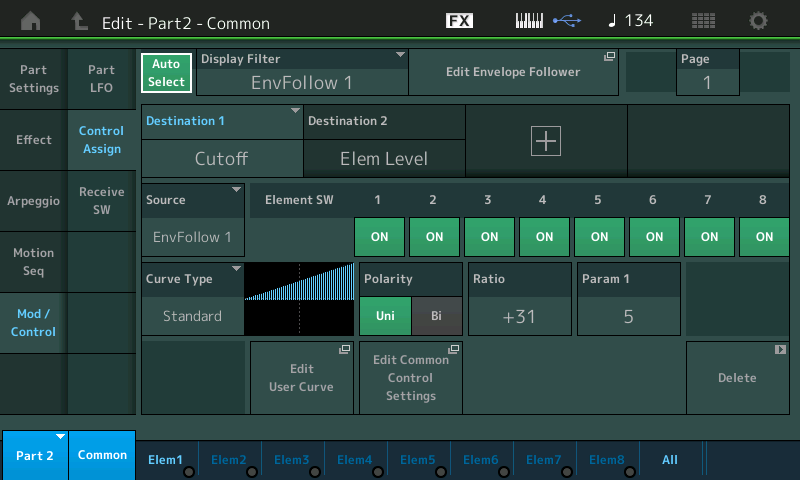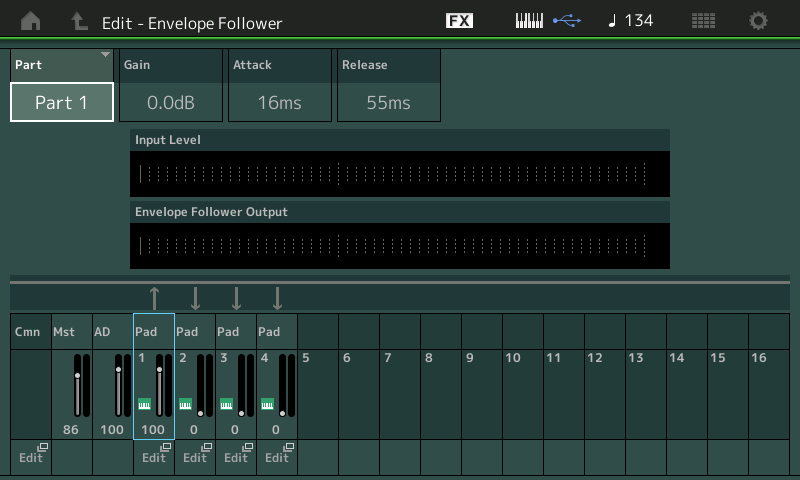I have been trying to figure out how the preset performance Vocoder & Follower works. But so far, it has me puzzled. In particular, the envelope follower setup doesn’t make sense to me.
The envelope follower display shows that part 1 is the source, and parts 2, 3, and 4 are the targets. I would think that this means that audio output from parts 2-4 is controlled by the envelope of part 1. But when I hold some keys down and say things into the microphone, the mixer display shows me that only part 1 is producing audio output. I don’t see how that could be possible.
I’m sure this means that there are some basic things that I don’t understand. I hope someone around here can point me in the right direction.
I just noticed that parts 2-4 have their levels set to zero in the mixer. When I set them to something higher, they produce audio as well.
But I still don’t understand how microphone input is controlling part 1.
An envelope follower is an indirect knob. There are 16 envelope followers. Each PART's envelope follower "knob" is controlled by the amplitude of sound energy that PART is producing. The sound energy for each PART need not be directed out to speakers -- the energy need not be "heard" in order for the knob to be affected by the energy. The more energy, the more the knob is turned up. The less energy, the more the knob is turned down. Extremes are from 0-127. It's difficult to make the knob swing from 0 to 127. Usually, you do not find a PART can produce dynamic range for full 0-127 swing. That's my experience. You get a band of maybe 64 steps and can offset that starting in the middle or starting low (generally).
At any rate - I say envelope follower is a "knob" to emphasize it's a controller, just about like any other. The difference is that instead of turning the knob with your fingers - the knob is turned by "loudness" of a PART.
Envelope follower is about the only controller that can jump from one PART to another. You can use Envelope Follower 1 (PART 1's sonic energy knob) in any of the PARTs (including 2-16). You do this by assigning a destination within any PART with a source as Envelope Follower 1. The destination determines what is modulated. Maybe it's pitch - maybe amplitude - maybe an effect parameter. Any of the things you can assign to modwheel or an assignable knob. Envelope follower it itself a virtual knob.
Still don't have my board up to go through the Performance you pointed out. That's a high level.
Current Yamaha Synthesizers: Montage Classic 7, Motif XF6, S90XS, MO6, EX5R
I have been trying to figure out how the preset performance Vocoder & Follower works. But so far, it has me puzzled. In particular, the envelope follower setup doesn’t make sense to me.
The envelope follower display shows that part 1 is the source, and parts 2, 3, and 4 are the targets. I would think that this means that audio output from parts 2-4 is controlled by the envelope of part 1. But when I hold some keys down and say things into the microphone, the mixer display shows me that only part 1 is producing audio output. I don’t see how that could be possible.
I’m sure this means that there are some basic things that I don’t understand. I hope someone around here can point me in the right direction.
Hi Michael,
Thanks for the question... Here's what's going on:
A good place to start when deciphering a Preset Performance is the OVERVIEW screen. You can get there one of two ways:
Press [SHIFT] + [HOME]
or
From the HOME screen touch "Motion Control" > "Overview"
From just this you discover that the Super Knob (blue) is set to do something to Parts 2, 3 and 4

With the cursor highlighting COMMON - we can use the shortcut button "Edit Common Control Settings" to see what's up with the Super Knob.
Touch "Edit Common Control Settings" to arrive on the upper level Control Assign screen. Activate the "AUTO SELECT" function and move the Super Knob.
Destination 1 = PART 2 ASSIGN 1
Destination 2 = PART 3 ASSIGN 2
Destination 3 = PART 4 ASSIGN 3

As you highlight these Destinations: 1, 2 and 3, you will see how they are each set to control two parameters; The "Destination 1/2" denotes one of two:
PART 2 ASSIGN 1 - Volume and Cutoff
PART 3 ASSIGN 2 - Volume and Op Level
PART 4 ASSIGN 3 - Volume and Op Level
Then by selecting PART 2 and reviewing its Control Assign we can learn about what is assigned to "follow" the Envelope created by PART 1.
Select PART 2 for EDITING
Touch "Mod/Control" > "Control Assign" > set the "DISPLAY FILTER" to "EnvFollow 1"

You can touch the shortcut box "Edit Envelope Follower" to arrive at the unit...

Set the PART = PART 1.
You can see that PART 1 (arrow upward) is the Source of the "Envelope", Parts 2, 3 and 4 are the "Followers" (downward arrows)
The Vocoder ensures that sound occurs only when air molecules are disturbed in front of your microphone and Notes on the keyboard are pressed. The Envelope Follower ensures that PART 2, 3 and 4 only sound when the Vocoder is active and the Super Knob applies Volume/Element Level to the PARTS under Control.
Hope that helps.
Thanks, Bad Mister. It was really helpful.
Is there a way to set things up so that the part with the vocoder isn’t heard through the speakers, but its envelope still controls other parts?
So of course, as soon as I posted that question, I figured out the answer which was to turn Part Output off for Part 1.
This vocoder plus envelope follower combo is pretty slick! I keep getting happier and happier with my Montage.

